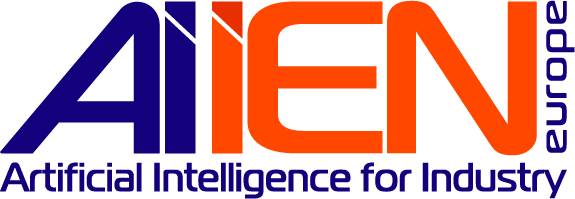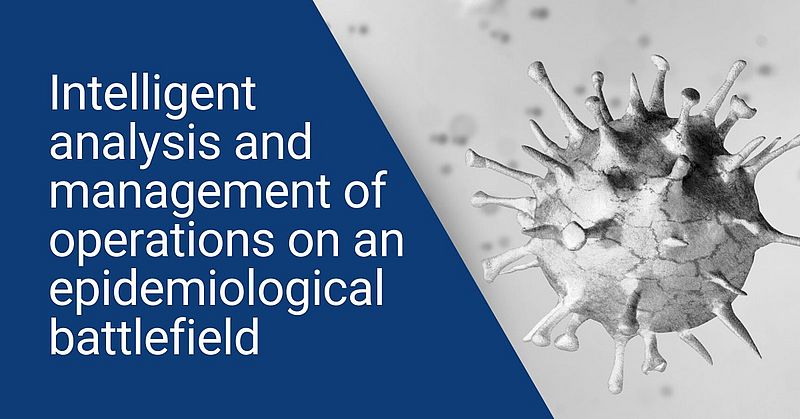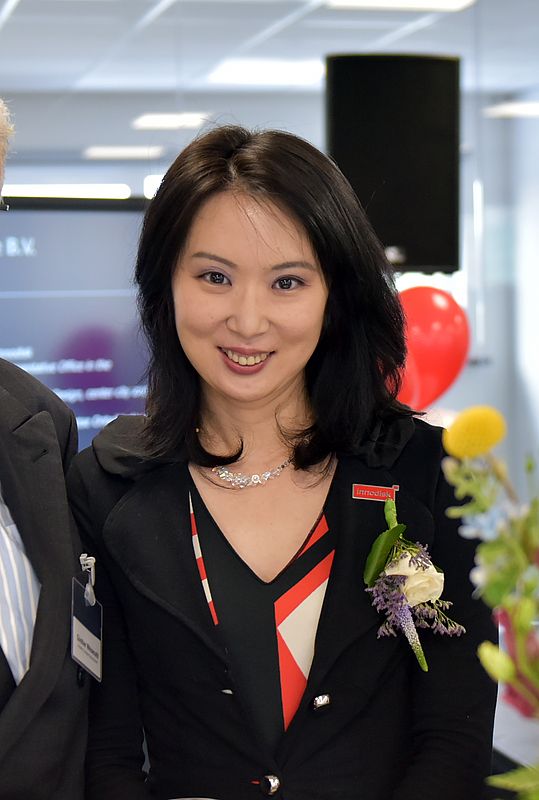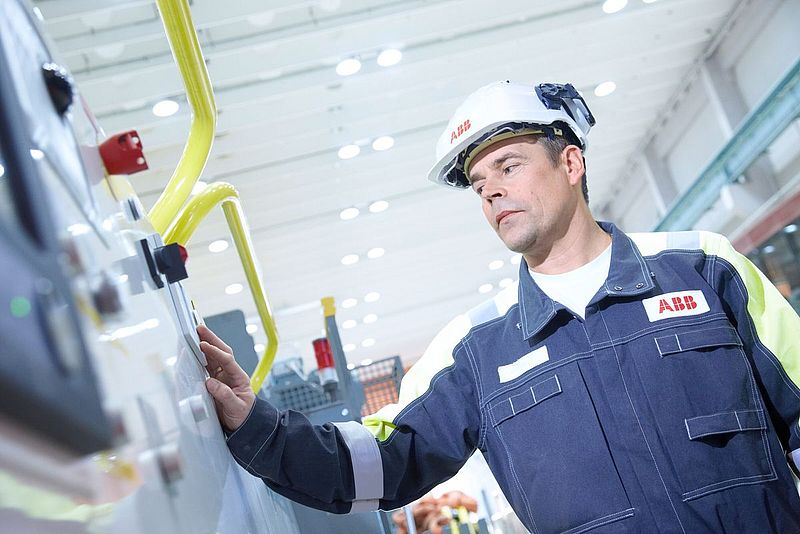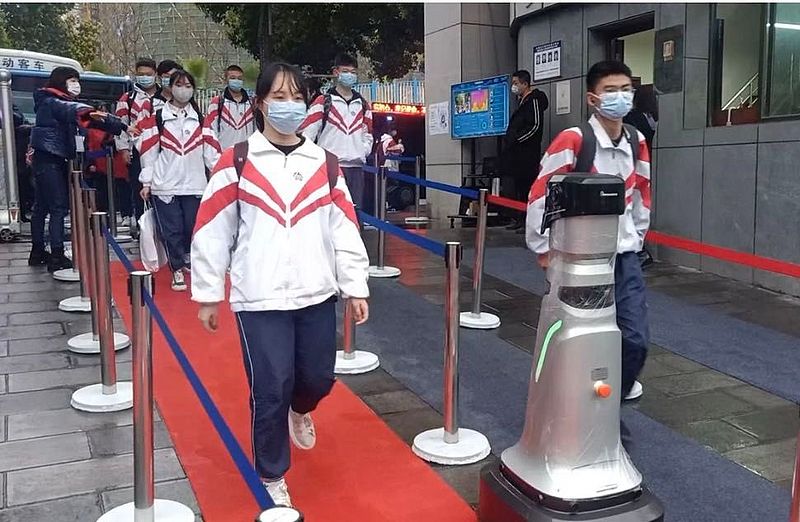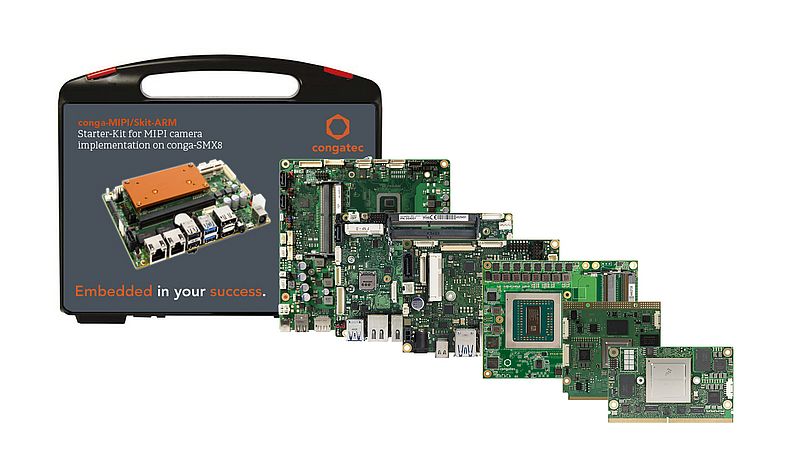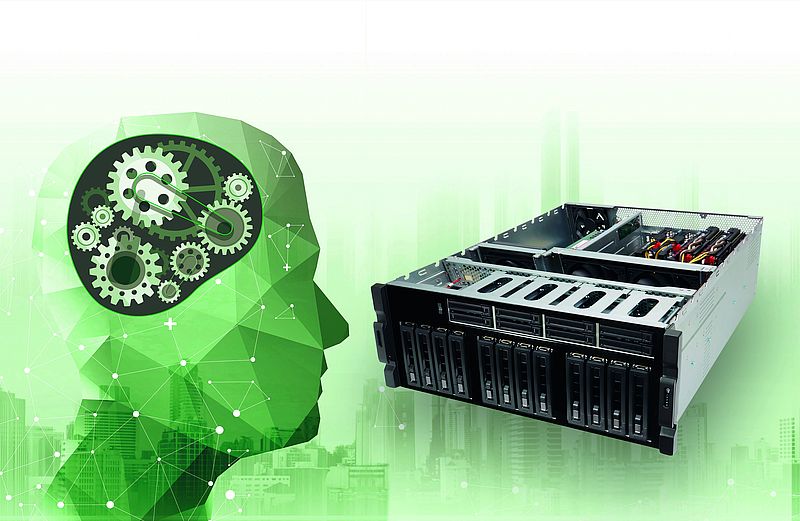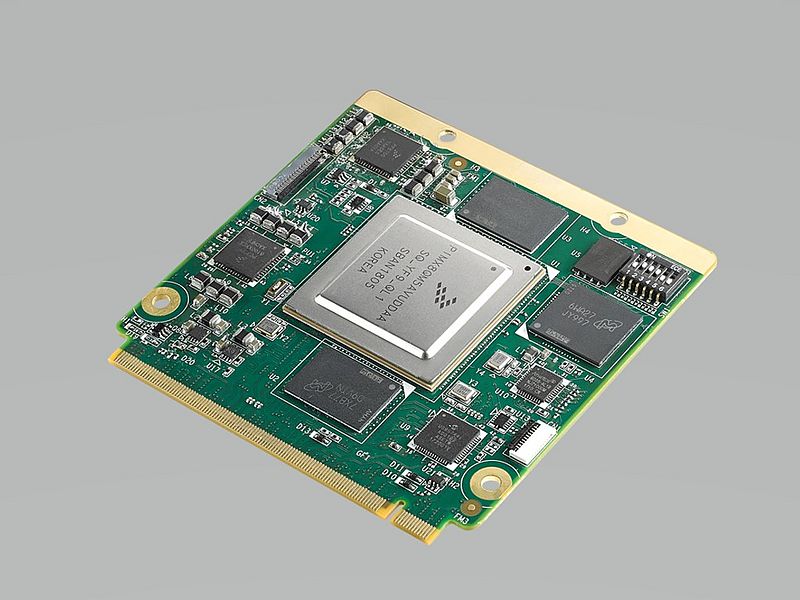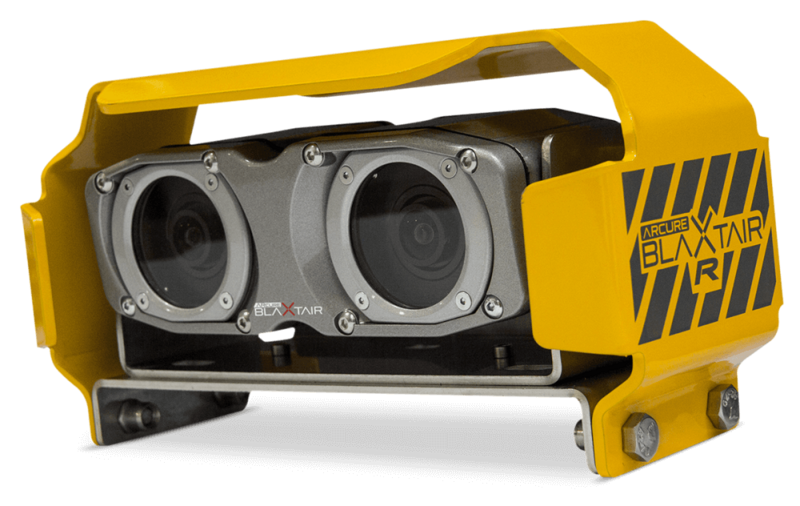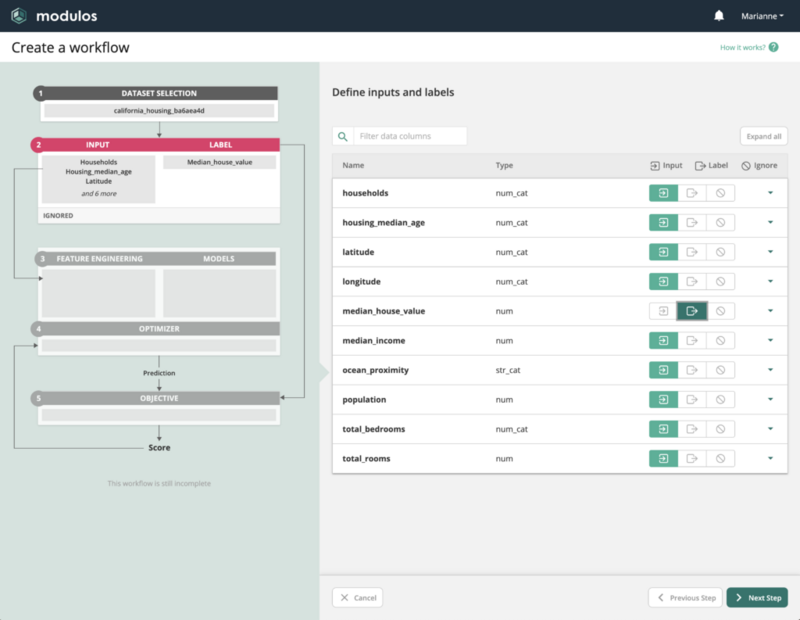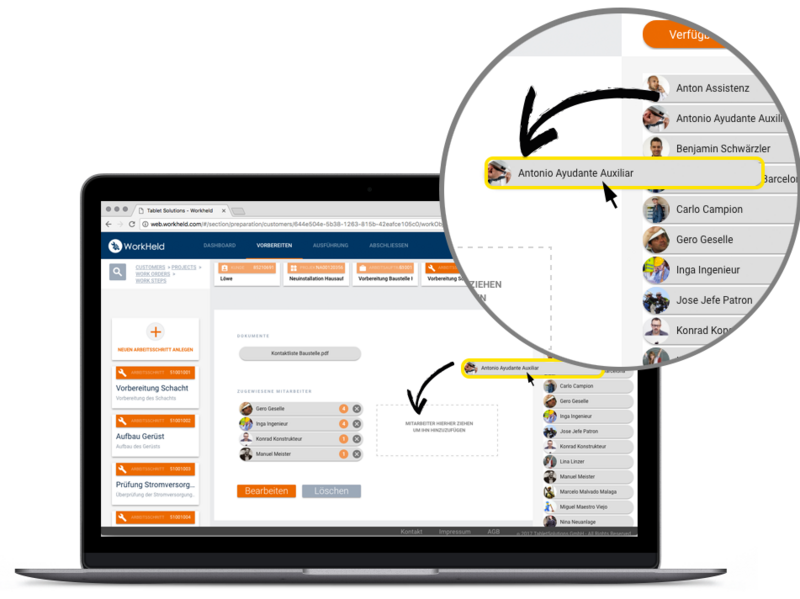Quick access
AI News: Xilinx & DataWalk2 AI News: Kontron & Unesco3 AI News: EuroTech4 Article: Resolto - Scraitec Platform5 Interview: Innodisk6 Applications: Mitsubishi & ABB7 Health Robots, RFP Ready Kit and Cleansing of Big Data Sets8 PC System, Anomaly Detection and Qseven Module9 Smart Camera & Machine Learning Platform10 AI Platforms11 Energy Optimization and Fall Detection12 Index13 Contacts14Xilinx Donates $1.1 Million to Fight Covid-19 Pandemic
Xilinx has donated $1.1 million for COVID-19 crisis relief to organizations that are critical to the global effort to combat the pandemic, to the local community in Silicon Valley, and to communities around the world
Artificial Intelligence, Automation, Industry 4.0, Covid-19
Xilinx is committed to fighting COVID-19. ''In times of crisis, actions speak louder than words. I’m proud to announce that Xilinx has donated $1.1 million for COVID-19 crisis relief,'' declared Victor Peng, CEO at Xilinx. Donations have been made to organizations that are critical to the global effort to combat the pandemic, to the local community in Silicon Valley, and to communities around the world, included:
- The World Health Organization (WHO) Solidarity Response Fund, which supports the WHO’s amazing global effort, supporting countries to prevent, detect, and respond to the pandemic.
- The University of California San Francisco (UCSF) COVID-19 Response Fund, providing care for coronavirus patients throughout UCSF’s hospitals, clinics, and research labs.
- The Silicon Valley Strong Fund, addressing the economic impact of the COVID-19 coronavirus pandemic on Silicon Valley residents, businesses and community-based organizations.
- Funds for key regions to be distributed by Xilinx regional leadership in support of local needs.
Additionally, Xilinx is matching employee contributions to relief efforts.
Healthcare industry committed to fighting the pandemic
For the company's healthcare industry customers whose products are critical to fighting the pandemic, Xilinx is providing special assistance, prioritizing product fulfillment and expediting shipments.
''I am profoundly proud and grateful of the Xilinx team and the extended Xilinx family of customers, partners, and vendors as we all work together to get through this extremely difficult time,'' continued Victor Peng.
DataWalk Extends Data Analysis Solution to Help Goverments Fight Coronavirus
A demonstration of the ability to use network analysis software to optimize allocation of resources during the pandemic
Artificial Intelligence
DataWalk, provider of one of the industry’s most advanced intelligence analysis software, announced that the company has demonstrated a solution that can help optimize allocation of critical resources during the Coronavirus epidemic.
On March 10, DataWalk published the first demonstration of its analytical platform to fight coronavirus. Now the company is demonstrating an extension to this solution - this time showing how advanced, scalable link analytics can help optimize the work of medical and public safety services.
Reports from countries heavily impacted by Coronavirus reflect that there can be critical shortages of both doctors and vital medical equipment (e.g., respirators, etc.) in areas of significant outbreaks. DataWalk engineers recognized that the company’s technology could use Big Data analytics to both predict locations of outbreaks, as well as identify how to optimally re-allocate personnel and equipment in order to maximize effectiveness.
Prediction of outbreaks and allocation of medical resources
“Not having the right medical resources and equipment in the right place at the right time costs lives,” said Pawel Wieczynski, DataWalk CEO for EMEA “Today we are demonstrating how DataWalk’s unique technology can enable health agencies to predict new outbreaks, and how and when to move medical equipment in order to best handle surges in demand.”
DataWalk provides a ready-made analytical environment to which organizations can add and connect any available data – such as hospital capacity, equipment inventory, immigration data, cell phone data, and anything else – to generate analyses and recommendations for optimal deployment of resources.
Unique DataWalk technology enables a solution to be deployed in hours, which is critical in a pandemic situation where speed is of the essence.
“Our unique technology enables us to quickly deploy and optimize sophisticated Big Data analysis solutions,” says Wieczynski. “We are ready and able to quickly assist governments and national/international health organizations in the fight against Coronavirus.”
Unesco to Develop the First Global Normative on the Ethics of AI
Unesco was tasked by its 193 Member States with the creation of the first global internationally applicable recommendations on ethical issues raised by the development and use of AI. The document will be drafted by 24 appointed world’s leading experts
Artificial Intelligence
Following the decision of Unesco's 193 Member States, made during its last General Conference in November 2019, Unesco Director-General Audrey Azoulay has appointed 24 of the world’s leading experts on the social, economic and cultural challenges of artificial intelligence to draft internationally applicable recommendations on ethical issues raised by the development and use of AI. The organization has the task to draft the first global normative instrument on this key issue.
The international expert group, which is composed of women and men from diverse cultural backgrounds and all geographical regions, includes leading scientists and professionals with extensive knowledge of the technological and ethical aspects of AI.
Complex AI choices
During their first meeting, 20 to 24 April, they will start examining the complex ethical choices which confront us in the emerging age of AI.
“It is our responsibility to lead a universal enlightened debate in order to enter this new era with our eyes wide open, without sacrificing our values, and establish a common global foundation of ethical principles for artificial intelligence,” said the Director-General.
The expert group has been tasked with the production of a draft text, which will be presented to various stakeholders at the national, sub-regional and regional levels for their comments this spring and summer. The text will then be submitted to Unesco’s Member States for adoption at the next General Conference.
Eurotech Congratulated by Frost & Sullivan for its Everyware Cloud
An IoT integration platform for data and deployment management
Artificial Intelligence
Based on its recent analysis of the global Internet of Things (IoT) platforms market, Frost & Sullivan recognizes Eurotech S.p.A with the 2019 Global Growth, Innovation & Leadership Frost Radar Award for its Everyware Cloud IoT Integration Platform. The full-suite platform can be hosted in the cloud, on-premise in a data center or at the edge to access, manage, and update devices. Its edge portfolio comprises IoT Gateways, edge servers, and high-performance edge computers for various vertical (stationary and mobile) markets and applications.
As a specialist in enterprise-ready IoT open source, Eurotech is a significant contributor and committed founding member of a strong open source ecosystem, centered on the Eclipse IoT Working group. It is an initial contributor to open source projects like Eclipse Kura, an IoT Edge framework and application development environment for IoT gateways; and Eclipse Kapua, an IoT platform for device management and data integration with Cloud and IT applications.
"Eurotech leverages its remote device management capabilities to easily connect devices with cloud services and visually compose data flows for the edge to manage, analyze, and route data," said Dilip Sarangan Industry Analyst. "With security at the core of its services and a microservice-oriented framework, it allows partners to create IoT solutions that enable customers to develop and deploy IoT solutions quickly."
In the cloud and on-premise
The differentiating flexible IoT Gateway and Edge Middleware provide device abstraction, multi-cloud connectivity, field bus integration, and security, thereby aiding full lifecycle management of the edge devices. Using the MQTT protocol for data and device management, Eurotech eliminates additional complexity and requirements for device deployment and configuration. Besides, as Everyware Cloud can be deployed both in the cloud and on-premise, it supports real-time data management, application lifecycle management, and remote access and diagnostics on devices. Eurotech also offers Web service APIs using REST protocol, which helps devices connect with the cloud and deliver microservices.
"Real-time analytics and data management are essential for most industrial companies looking to integrate IoT in their operations. By enabling these services, Eurotech underlines its leadership in IoT platforms," noted Sarangan. "With a wealth of integration possibilities, including DB and ESB integration, message routing, pre-defined Kafka routes, and rich APIs, Eurotech bridges IoT operations with IT. This important service endows the company with a critical competitive edge and cements its leadership in IoT."
The Growth Innovation Leadership (GIL) best practice award is bestowed on companies that are market leaders that are at the forefront of innovation. These companies consolidate or grow their leadership position by continuously innovating and creating new products and solutions that serve the evolving needs of the customer base. These companies are also best positioned to expand the market by strategically broadening their product portfolio.
"The combination of our strong expertise and hardware does significantly reduce the risk and cost associated with designing, deploying and maintaining IoT solutions." Robert Andres, Chief Strategy Officer of Eurotech
Frost & Sullivan Best Practices awards recognize companies in a variety of regional and global markets for demonstrating outstanding achievement and superior performance in areas such as leadership, technological innovation, customer service, and strategic product development. Industry analysts compare market participants and measure performance through in-depth interviews, analysis, and extensive secondary research to identify best practices in the industry.
“Eurotech has been delivering cutting edge distributed computing and IoT solutions for nearly three decades. Eurotech development teams in geographic regions worldwide are helping global customers accelerate their digital transformation” says Dusty Kramer, CEO Eurotech North America. “Our recent wins with enterprise customers and large system integrators within North America are leveraging Eurotech’s integrated hardware, software, and professional services. These results are recognized by Frost & Sullivan analysis of IoT Platforms available within the market.”
“We are proudly receiving this important recognition from Frost & Sullivan,” commented Robert Andres, Chief Strategy Officer of Eurotech. “It is documenting the successful implementation of a strategy that is focusing on encapsulating the technical complexities of IIoT addressing the challenges and requirements of customers with demanding applications in as different verticals as industrial & manufacturing, utilities & energy, medical and transportation. The combination of our strong expertise and hardware offering in various vertical markets with our open IoT software architecture and ecosystem approach, does significantly reduce the risk and cost associated with designing, deploying and maintaining IoT solutions.”
Bringing Artificial Intelligence Directly to the Machine
AI specialist Resolto is bringing AI directly to the machine and interpreting data there with its Scraitec platform, for example at a household appliance producer and a car manufacturer
Artificial Intelligence
Up to now, industrial applications of artificial intelligence (AI) have been less than impressive due to latency periods and the high quantities of data involved in connecting to the cloud. The crucial factor is therefore bringing AI directly to the machine and interpreting data there – directly at the source – in real time. AI specialist Resolto is doing exactly this with its Scraitec platform, for example at a household appliance producer and a car manufacturer.
Resolto Informatik GmbH has been part of the Festo Group since 2018, and supports the leading manufacturer of automation solutions in getting its pneumatic and electric automation technology ready for Industry 4.0. Data is interpreted already in the field in close proximity to the machines. This makes it possible to save energy, shorten cycle times, and it reduces machine failures and production errors.
Festo products with AI
The Scraitec software solution from Resolto knows the healthy condition of a plant and detects every anomaly with the real-time analysis of the plant’s sensor data. Scraitec supplies early and precise prognoses, makes diagnoses and supplies recommendations for action. “The topic of analytics and artificial intelligence will have an effect on Festo’s product portfolio, since AI algorithms can be integrated both in the cloud and directly in the components from Festo,” says Tanja Maaß, Managing Director of Resolto, in describing the benefits of the collaboration.
With the Festo IoT Gateway CPX-IOT as hardware, customers can have their machine and plants monitored at field level. Field level support is provided with the ScraiField software component. This component runs constantly in close proximity to the machines in a smaller controller. A pretrained model with minimal hardware requirements that reliably interprets data streams without the need for a data connection to the central component located in the cloud (ScraiBrain) is used. The IoT gateway connects to the cloud, the Festo dashboards, as necessary. The ScraiBrain is embedded there with access to a host of preconfigured application models.
Human-in-the-loop principle
“The platform continuously learns from actual operation, integrating the knowledge of the engineers and the customer’s technical experts – we call it the ‘human-in-the-loop’ principle,” explains Maaß. The machine learning and AI product interprets information predictively in order to actively optimise parameters in plants or to send concrete instructions for action to “its” people (e.g. via smartphone).
New business models
Combining Scraitec with plants and machines to transform them into digital tools is opening up new business models for machine and plant manufacturers. New service concepts offer substantial added value through the automated, early coordination of the in-house maintenance teams.
Scraitec helps end customers to optimise the utilisation of their plants using automation. The costs for maintenance are reduced, since maintenance schedules can be adapted by predicting events and recommendations for action for known fault patterns. The platform improves all plant parameters for defined target criteria and increases the plant’s productivity.
Fault avoidance in complex production lines
As a case in point, household appliance manufacturer Miele noticed fluctuating product quality in its production process over a given period, but was unable to account for the causes. It operates complex production lines, where products are manufactured in sequential order. It is not enough here to look at the individual stations separately.
The production managers at Miele therefore wanted a system for automatically detecting anomalies in complex manufacturing flows. “Deep Learning seemed to be the right approach for this,” explains Maaß. What was needed was to develop an integrated data base that brought together different measurement systems. Additional measuring points also had to be configured for this. The Scraitec platform modelled the production lines as an integrated system, and by so doing increased throughput by 1.5%.
An automobile manufacturer is another case in point, with a pneumatic clamping system costing the car manufacturer just € 100. However, an unforeseen production stoppage can cost several hundred thousand euros. An early warning system for wear and slowing down of cycle times was therefore ideal – more precisely a learning system for the predictive maintenance of all types of clamping systems. The solution with Scraitec for real-time data analytics incorporates the Festo controller CPX-E-CEC directly. A connection to the cloud is not necessary.
''AI and AIOT Are Setting the Democratization of Computing Power and Connectivity’’
Embedded technologies are opening up new applications that were unthinkable before. For Anita Po, Managing Director of Innodisk Europe, AI, 5G and intelligent edge will significantly drive the technological progress by unleashing creativity and innovation
Artificial Intelligence
IEN Europe: What does the shift towards AIoT and 5G bring as a change in the industrial landscape?
A. Po: AIoT and 5G technologies are unleashing staggering efficiency gains and exciting opportunities for innovation in automation, ushering in a new era of manufacturing. This industrial renaissance will have enormous positive implications for both manufacturers and consumers, and we're only at the very beginning of this monumental shift toward smart automation.
At the center of all this exciting innovation is data—the generation and processing of vast amounts of data. With 5G and the vast volumes of data it will bring, the demand for effective data processing abilities will rise even further, which in turn demands higher-performance components, faster and higher-capacity storage, and smarter edge devices. All of which also require exceptional security and reliability.
IEN Europe: In which sense is Innodisk "Building an Intelligent World" through its AIoT Ecosystem?
A. Po: We take the word "World" quite literally in our slogan. To bring AIoT technologies to the factories, vehicles, and homes around us—while an important goal—realizes only a fraction of AIoT's full potential. Instead, we have designed our ecosystem to bring AIoT to even the most remote, harshest, and most demanding applications around the world. Think, for example, of what AIoT could do for a research station in Antarctica or a solar farm in a remote part of the Sahara. We design our solutions with such applications in mind. The result is that our solutions are well-equipped to take on challenging applications anywhere in the world. We believe that only then can AIoT reach its full potential.
But our work doesn’t stop there. For Innodisk, building a full AIoT ecosystem is absolutely central to our mission. Since AIoT challenges are highly complex, they also require comprehensive solutions that can fully address these challenges. Our vision of “Absolute Integration” is central to our company culture, and we work tirelessly to unite our hardware, firmware, and software expertise with the knowledge and expertise of our partners and clients to push the world toward the AIoT industrial revolution.
IEN Europe: Why embedded technology is playing an increasingly important role today?
A. Po: As we can pack more power in smaller and smaller form factors, it allows embedded technology to be deployed in applications that would have been unthinkable only a few years ago. This technological leap, combined with increasingly sophisticated software and rugged technologies, is about to make businesses' creativity the last limitation to where we see embedded systems getting deployed. And we expect limitless creativity.
Picture, for instance, a smart city. Everything we encounter in our daily lives will be connected and smarter: transportation infrastructure, factories, retailers, and even medical services will be powered by connected AIoT technology.
IEN Europe: What did you showcase at this year's Embedded World? Is this show a benchmark for the sector?
A. Po: We always have a great time at Embedded World, and this year was no exception. For Innodisk, it's as much an opportunity to showcase our latest solutions as it is a chance for us to learn more about how our colleagues are helping us push the industry forward.
Some of the solutions that attracted the most interest this year were our InnoAGE SSD—a smart SSD that can be managed through an independent communications channel; our AI accelerator modules—which bring exponential performance gains to AI on the edge; and our high-performance DDR4-3200 DRAM modules—ideal for any application requiring exceptional performance.
This year, we also worked closely with our ecosystem partners to demonstrate how we're bringing our technologies and expertise together to advance AIoT and bring the future of intelligent devices to the present. For example, we presented solutions from our partners at ASUS and DFI, each incorporating Innodisk's cutting-edge InnoAGE SSD.
IEN Europe: How does AI, 5G and edge technology contribute to the technological progress?
A. Po: At Innodisk, we believe that AI, 5G, and the intelligent edge will prove some of the most important driving forces behind economic and social development in the next few decades, and we are planning our priorities and placing our investments accordingly. Perhaps the most important reason that we see these technologies as representing such a massive shift is that they hold so much promise for virtually every industry and type application.
With these technologies, it won't just be massive factories or the world's largest companies that find new ways to increase efficiency and profitability. More importantly, we see these technologies as the democratization of computing power and connectivity, giving individuals and small and medium-sized companies access to top-of-the-line equipment and data processing abilities, and in turn, unleashing a wave of creativity and innovation.
Things that were only possible to achieve with massive computer farms, industrial-scale data centers, and an army of staff will be well within reach for anyone with a good idea and AIoT tools widely available to anybody. This is where we expect AI, 5G, and intelligent edge technologies to have the most significant impact on technological progress.
IEN Europe: Where is Innodisk positioned on the market? What are your future objectives?
A. Po: We are doubling-down on our 15 years of experience in industrial-grade integrated solutions as we move into the age of 5G and AIoT. We are reorienting ourselves into an even more full-fledged solutions provider. We have made substantial investments in ensuring that we can provide customers with 360-degree solutions to their 5G and AIoT challenges. What this means in practice is that we have expanded our software teams to allow even greater hardware-software integration and even more sophisticated software solutions. This vision has also been a driving force behind our acquisitions of companies like Aetina, Antzer, Millitronic, and Sysinno.
Looking forward, we are focused on expanding our AIoT ecosystem even further through strong partnerships with other industry leaders—both by working even closer with our current partners, like Microsoft, and by welcoming new partners into our ecosystem. We strongly believe that working together as an industry is vital to advancing these technologies, and we are more than happy to spearhead these industry collaborations.
Sara Ibrahim
How Will Advanced Analytics and Artificial Intelligence Drive Development in Industrial Machine Control?
Smart technologies are extending traditional machine control architectures with more enhanced data processing, learning and decision-making capacity
Artificial Intelligence
These smart technologies are extending traditional machine control architectures with more enhanced data processing, learning and decision-making capacity. They hold the potential of increased availability, efficiency and reliability through predictive and prescriptive maintenance, as well as improving productivity with the ability to make autonomous decisions.
Piotr Siwek, Head of Product Marketing EMEA, Factory Automation, Mitsubishi Electric Europe B.V. looks at how embedding these smart technologies in controllers can deliver a new paradigm of machine operation.
It wasn’t so long ago that the potential of technologies such as model-predictive control, PID control, field-oriented control and fuzzy logic was merely hypothetical. Today, they are so deeply embedded within controller architectures that we no longer even think about them.
Within that context, consider the development possibilities of advanced analytics (AA) and artificial intelligence (AI) technologies for machine control. They can be a driver for increased machine availability for example by delivering more effective predictive maintenance.
This brings us into the realm of Big Data analysis where AA and AI technologies enable different machine states to be recorded and analysed in real time. Recognising the current machine status, detecting potential faults on the horizon, and then immediately offering recommendations for actions to be taken. The machine operator or maintenance provider can respond, or the system even autonomously initiates remedial actions.
By linking that same AI technology into the wider enterprise, into the logistics chain for example, the control system could even mitigate for delays in the delivery of replacement components. For instance, it could slow the machine down slightly to increase longevity rather than stopping the production line altogether.
Going further, AI can begin to make autonomous decisions to optimise productivity. Consider, for example, how a machine is typically built to work within defined margins of capability – perhaps to allow for different loads or speeds or safety ranges. AI technology using deep learning algorithms within the controller could enable machines to be driven right up to and even beyond today’s margins, significantly boosting productivity without compromising reliability or safety.
We are already seeing how applying AI principles to individual machine processes can be an enabler for operational improvements. For example, Mitsubishi Electric has developed diagnostic technology based on its AI Technology called Maisart. Embedded into products such as Mitsubishi Electric’s MELIPC edge computing solution, this uses machine learning to analyse collected data to generate a model of the machine’s operational states. This model can detect abnormalities in the machine’s operation in real time, enabling it to provide early warning of impending problems so that maintenance personnel can take prompt action.
Another example of the use of AI is the smart predictive maintenance function of MELFA robots. The Smart Plus function can be applied to Mitsubishi Electric’s MELFA robots to precisely analyze primary drive components according to actual operating conditions and warns of failing or deteriorating parts at an early stage. Therefore, reducing downtime and allowing an efficient maintenance schedule to be planned. Further, during the design phase of the applications, the technology offers simulation capabilities to predict the robot’s lifetime and estimate annual maintenance costs, giving engineers the opportunity to modify the robot’s operation to extend the lifecycle.
These two examples already could drive significant improvements in availability of the machine and reduce maintenance costs, yet they merely hint at the potential of AA and AI.
By Piotr Siwek, Head of Product Marketing EMEA, Factory Automation, Mitsubishi Electric Europe B.V.
Predictive to Prescriptive?
With the advent of the Internet of Things it is now possible to predict failures and downtimes without the need to carry out unnecessary maintenance. This offers a more dynamic and controlled approach to maintenance
Artificial Intelligence
Today, the Internet-of Things-technology is permitting industry to use data gathered through automation to actually predict when a failure may be imminent, and thus prescribe mitigating actions to maintenance personnel, based on historical data, that takes into account the specifics of the individual process, product being made, and environment in which it is being made.
This offers a far more dynamic and strategic approach, which helps to avert imminent failures, greatly assists with planning preventive maintenance and optimises production uptime.
Moreover, there is potential to significantly reduce overall maintenance costs because resources can be applied at the most optimum time, and the level of insight garnered allows for a specific preventive solution to be applied.
Predictive and prescriptive maintenance are terms that are often used interchangeable and are at times confused and misunderstood. Predictive maintenance is being adopted widely. Prescriptive, on the other hand, while fast growing, is still in its early stages and represents the “gold standard” industry is endeavouring to move towards.
The challenges facing predictive maintenance
There are huge advantages of moving on from preventive to predictive maintenance. However, most current predictive maintenance efforts will predict failure due to occur (pre-conditions) but can’t give information on probability of failure or prediction of time to failure. There are some further challenges that are worth noting.
Setting the conditions for successful predictive maintenance
Simply put, condition monitoring is at the crux of predictive maintenance efforts. Using sensors and field devices to gather information on machinery to provide intelligence allows engineers to determine when the equipment actually needs to be serviced, rather than relying solely on pre-determined time intervals. Data is provided in real time and generates a regular stream of information on equipment and operational status, informed by regular and continuous assessment and anomaly detection.
The sensors and devices employed can be connected to the plant network, and even be shared across an enterprise through Internet of Things technology. Edge and cloud applications have been important drivers of predictive maintenance, as they create greater opportunities to harness, process, share, and employ data obtained from a wide range of sources.
Producers are able to use increasingly higher volumes of data on asset conditions to create deeper insight and better analytics for asset management.
The power of prediction
The benefits of predictive maintenance are not limited to more efficient and precise maintenance scheduling. There are also operational benefits to plant operations which are, understandably, a key part of its appeal. Ensuring timely maintenance helps industrial producers avoid equipment failure and the inevitable costs of downtime. Performing maintenance only when necessary also reduces the overall financial burden of maintenance across the asset’s lifespan, compared with interval-based maintenance.
The power of advanced predictive maintenance means that analytics can be generated in order to show that equipment needs to be repaired in order to avoid failure. Crucially, especially from a commercial or critical infrastructure perspective, it can also provide additional information on the probability of failure as well as an accurate prediction of time to failure.
Producers can plan exactly which maintenance activities to prioritize, and which to postpone without risk of failure. They can group together maintenance actions and be proactive in addressing imminent issues, depending on the probability of failure in the foreseeable operational future.
Prescriptive maintenance and machine learning with humans at the core
As each day passes, our ability to understand our assets and how they function is improving. Machine learning, via advanced data analytics, can help us recognize when they enter failure modes.
Many can now identify the pre-conditions around them. Because these processes are automated, they reduce the burden on maintenance teams and allow a higher level of input by the people monitoring the equipment as they are empowered to make data-driven decisions about maintenance action (or inaction).
The aim is to use artificial intelligence applications to understand and spot patterns that ultimately lead to equipment either experiencing an issue or stopping working all together. Then, moving beyond simple monitoring and recommending, these applications can be programmed to make their own decisions as to the next maintenance steps, and to act on them automatically, insofar as this is physically possible.
If there is enough intelligence in the system, in theory, the plant can operate with less frequent human interaction in terms of overview and correction when the plant’s assets encounter disruption or enter unexpected states. This means that there is a huge potential for greater agility and operational responsiveness that drives productivity and profitability.
Asset sensors will collect data on an ongoing basis, measure it against information gathered from other machines and broader data stored in the cloud, subsequently generating insights and actionable responses for engineers in real time.
In the not-too-distant future, we will see a wider adoption of prescriptive maintenance, which truly offers a more dynamic and controlled maintenance approach. In order to do this however, there will need to be small changes in thinking and some different processes put in place if it is to be successfully applied in a live industrial setting.
What’s next?
The potential for technology to contribute to a further evolution of industrial maintenance cannot be understated, and the possibility of building on predictive and moving ever closer towards prescriptive maintenance is exciting for those working in industrial operations.
However, even with the very best advanced services, technology and predictive maintenance, and regardless of how much automation can augment physical service operations, impactful and meaningful maintenance actions need highly experienced people to understand and respond to the information generated.
Operators must tackle the barriers to successful implementation of predictive maintenance in order to build a stable and optimal platform for future adoption of prescriptive maintenance.
By Paul Gogarty, Asset Lifecycle Product Manager at ABB Industrial Automation Service
Smart Patrol Robots with Edge Gateway
Deployed to support disease prevention and inspection
Automation, Sensor Technology, Test & Measurement, Artificial Intelligence, Covid-19
Since the outbreak of COVID-19, Shenhao Technology Co., Ltd has deployed smart robots that use Advantech technology to monitor body temperature and conduct identity detection in schools, banks, and other public places. Shenhao’s Health Guardian 1 is equipped with Advantech’s UNO-2484G edge gateway to give a hand in disease prevention and inspection. These robots can measure body temperature through infrared sensors capable of scanning temperature within a 5-meter area. All collected data is sent to a centralized server or management dashboard for health screening.
Widely deployed in southern cities of China
When it comes to autonomous movement and navigation, the robots are integrated with simultaneous localization and mapping navigation (SLAM) technology. To ensure the stable operation of robots and collect accurate raw information, Health Guardian 1 robots are equipped with Advantech’s UNO-2484G gateway, a highly ruggedized embedded operation system powered by an Intel® Core™ i7 processor. The built-in Intel® i21 0 Ethernet controller and 8GB memory facilitate I/O-based control and convenient operation.
IoT RFP Ready Kit
Engineered for real-time workload consolidation
Automation, Artificial Intelligence
At Embedded World 2020, Congatec focused on embedded edge computing. Among their solutions, the new Intel RFP Ready Kit for real time workload consolidation has been compiled together with Intel and Real-Time Systems. It enables OEMs to directly start with the development next generation of vision-based collaborative robotics, automation controls and autonomous vehicles that have to tackle multiple tasks in parallel, including situational awareness utilizing deep learning based AI algorithms.
From high-end to ultra-low-power edge servers
The RFP Ready Kit utilizes the RTS Hypervisor from Real-Time Systems on Congatec’s COM Express Type 6 based Intel® Xeon® E2 industrial application server platform and comes ready to order with everything designers need.
Platform for Cleansing, Structure and Annotation of Big Data Sets
A preparation for advanced AI applications
Artificial Intelligence
BrainMatter is an AI platform made by BrainCreators designed to allow enterprise customers to cleanse, structure and annotate big data sets with maximum scalability. Regarding machine learning, data is a bigger challenge than models and algorithms. Thus, BrainMatter enables large organizations to annotate data sets at scale and prepare for advanced AI applications. It enables the user to explore, understand and enrich the digital intelligence portfolio. It works adding human domain knowledge to the available data, and preparing for future solutions as efficiently as possible.
Turning human knowledge into digital intelligence
BrainMatter is built with a sharp focus on user experience to allow domain experts, managers and workers to use the platform without the need for a data scientist. Each enriched dataset becomes a proprietary valuable asset that can be leveraged by automating tasks and driving more informed decision making. The product is currently being tested by Rijkswaterstaat, part of the Dutch Ministry of Infrastructure and Environment, and also responsible for the design, construction, management and maintenance of the main infrastructure facilities in the Netherlands.
The Grand-C422 is a 19” PC System from ICP Deutschland is designed to answer the requirement challenges for image processing, rendering or mining. It can be equipped with a 4 to 18 core processor of the Intel® Xeon® W family based on the LGA2066 socket. A water-cooling system is implemented as CPU cooling, which can dissipate up to 250W TDP waste heat. Its DDR4 main memory can be flexibly expanded from 32 GB to 256 GB, depending on the computing power required.
19” AI training systems for high performance image processing and mining systems
The four PCIe 3.0 x8 and two PCIe x4 slots offer space for a total of four dual-slot and two single-slot graphics cards. Moreover, the PC System provides mass storage options, with six 2.5” and 12x 3.5” STA 6Gb/s slots, as well as M.2 NVMe slots and two U.2 interfaces. In addition to an Intel GbE network interface, the GRAND-C422 also offers an Aquantia AQC107 network interface with a transmission speed of 10Gb/s. The power supply for the high-performance system is provided in the temperature range of 0~40°C via a redundant 110~240VAC 1600W power supply.
Data Extraction with AI-powered Anomaly Detection
Identifies technical faults through advanced diagnostic analytics
Industry 4.0, Artificial Intelligence
YANOMALY is a software solution from Yazzoom which aims to answer the today’s data challenges, such as the difficulty to extract valuable information. It allows to use the data collected from machines, assembly lines, packaging lines and continuous or batch production processes, for real time monitoring in the condition of the user’s assets through AI-powered anomaly detection. Thus, the goal is to troubleshoot technical faults or production issues through advanced diagnostic analysis and to build predictive or prognostic models using high performance proprietary machine learning algorithms specifically developed for industrial data.
Easy integration into existing monitoring platforms through a modular highly scalable architecture
The software includes web-based GUI to allow non data scientists to select data, train the computer models, and to validate, deploy, and monitor and maintain those models. Designed to be interfaced or integrated with existing data monitoring or IoT platforms, YANOMALY can process all types of data from sensor signals and other time-series data to event logs or machines, categorical data coming from ERP and MES systems and more. It features AI-powered functionalities such as anomaly detection. This functionality can be helpful since 80% of downtime is caused by never-seen-before technical or process issues. The software doesn't need an issue to have already occurred in the past to detect it. The diagnostic analytics module enables to identify the main factors that influence key performance indicators and metrics. Last, the predictive modeling (virtual sensors) helps build machine-learning models and deploy them in production.
Arm-based Qseven Module
Designed for AI and machine vision applications
Industry 4.0, Vision & Identification, Artificial Intelligence
Advantech released its first NXP i.MX8 product with the ROM-7720, an Arm-based Qseven module powered by the NXP Arm® CortexTM-A72 i.MX8 high-performance processor. It supports 4K resolution via HDMI 2.0 with H.265 H264 hardware accelerator engines for video decoding and additional GPU for image processing. The ROM-7720 utilizes OpenVX and is suited for AI, machine vision, and big data processing and analytics applications in the IoT era.
Power computing performance and high-speed interface
The new Qseven module adopts NXP i.MX8 Quad Max SoC, which integrates two CortexTM-A72, four Cortex-A53 and two Cortex-M4F processor cores and the Vivante GC7000XS/VX graphics engine, which supports OpenGL ES, OpenCL and OpenVL (vision) SDK for developing images, data processing, and analytics applications. It supports display output with HDMI2.0 (3840 x 2160 @60Hz), dual 24bit LVDS for multiple displays, and 2 + 4 lanes MIPI-CSI camera input. It supports a high-resolution display and meets the camera requirements of different machine vision applications. In addition, it offers new high-speed I/O, including USB 3.0, PCIe 3.0 and SATA 3.0. It offers efficient interfaces for extending peripheral devices such as the SSD, 5G cellular card, and FPGA IC to empower new AI and machine vision development.
Blaxtair is a pedestrian/machinery detection system for industrial vehicles such as forklifts, designed to prevent collisions between vehicles and pedestrians in co-activity zones. This smart 3D camera can distinguish a person from another obstacle in real time and alert the operator in case of danger, without unnecessary alarms.
A visual and sound signal to alert the driver if a person is detected in the danger zone
The anti-collision camera comprises a camera, calculator and LCD screen. It utilizes a sensor to continuously scan the blind areas around the machine and display the environment in 3D. Based on video recognition algorithms developed by the French Atomic Energy Commission, it can precisely identify the nature of each obstacle. Combined with effective organizations and best practices, it is a fitted solution to the safety parameters required in industrial applications, material handling, recycling, infrastructure construction and quarry or mining.
Modulos provides an AutoML platform designed to take advantage of the latest AI technology without being an expert. By simply dragging and dropping a dataset into the system, the platform automatically deals with model selection, hyper-parameter tuning, quality monitoring, control, and more. The system’s knowledge also gets updated whenever a new Machine Learning technique is published online to make sure to be up to date.
Make AI easier to use without simplifying it
The platform functions by uploading the training data to let the system automatically analyze the dataset. The user specifies the label and what information to ignore, then selects feature extractors, models, the optimizer and the objective to use the default settings. Besides, the Modulos AutoML platform will find the best AI solution and provide insights which allow to monitor the process. Last, as the AI solution is ready, the user can download the best model and feature extractor pipeline, and make predictions on a new dataset.
Bitmotec, a high-tech company specialized in the industrial technology sector, develops customer specific software and hardware in the IoT, AI, Data Science, Computer Vision, Virtual Reality, Augmented Reality and Automation Technology areas. They combine established approaches with the latest analysis methods, such as deep learning. Among their solutions, the Industrial IoT Platform forms the basis for comprehensive analyzes of the company's data. It aggregates the collected data and displays them on a modular dashboard tailored to the specific application.
The user is made able to identify new potential clearly, quickly and easily, and to derive optimization approaches
Regarding the comprehensive analysis of a company's data, the latest state-of-the-art and research methods are available. Their infrastructure monitoring system comprises an AI node with standardized interfaces (MQTT, IO-Link, LoraWAN and GigE) for industrial sensors and cameras and a modular dashboard with notificator (email, teams, Slack).
Platform for Connected Workforce Management
Increases the efficiency and transparency of industrial processes
Artificial Intelligence
WorkHeld is a software platform made by Tablet Solutions that increases the efficiency and clarity of industrial production, assembly and service processes. The system creates a platform for efficient planning, execution and documentation. Among its key features are available planning tools, an integrated equipment, material and tool management as well as numerous functions for working documentation and travel times, defects, expenses, material consumption and other relevant data including images and documents.
Teleworking for maintenance providers
Reports can be generated automatically and signed directly on site by the customer or technician. WorkHeld thus digitalizes the entire process from order allocation to the customer's signature. WorkHeld is also the first solution of its kind with an intelligent voice assistant for technicians and an artificial intelligence for scheduling technicians and forecasting material consumption.
Metron-EVA is a platform made by Metron to automate the monitoring of data quality and integrity. It virtualizes the plant and creates digital models of real assets. Moreover, it structures energy and industry knowledge into ontologies, and interacts with humans to understand the industrial context and qualify the data. The user thus validate on the platform the data collection of the industrial site, check the mapping of the plant's devices, as well as all energy vectors.
The Digital Platform will ultimately promote fully managed renewable energies, new energy usages, peer to peer energy exchanges, and more
Metron's AI is based on Machine Learning, ontologies and a virtual assistant. Their Machine Learning engine, packed with algorithms and autonomous agents (such as Random Forest, Neural Network, Deep Learning) brings simulation and prediction capabilities. Ontologies map in a knowledge graph industry processes and energy sources. They provide Metron's AI the context and knowledge required for custom made optimization opportunities. Last, the virtual assistant collaborates with humans using NLP (Natural Language Processing).
Visual Alert System in Case of Fall
Detects and analyzes the behaviors in a room
Artificial Intelligence
VA²CS is a company that made up an innovative AI enabling automatic detection in case of a fall or abnormal behavior from isolated older people. This AI will in the future be able to predict a fall with high efficiency and warn families or healthcare people before it occurs. In such a period in which contact avoidance is recommended, this solution is fitted to keep an eye on vulnerable people by upstream security and prevention in case of immobility.
Suitable for intrusion detection, identification, fall, run away, behavior deterioration, loss of consciousness and night-time sunrise detection
Asked about the future of the use of AI technologies as prevention tools, Ramzi Larbi, CEO and founder of VA²CS answered: “I do think that we will use more and more prevention tools such as VA²CS. Before this health crisis, the population may think that AI devices were coming to replace humanity, but the post-crisis situation will maybe demonstrate something else. The population may now understand that AI tools are designed to help us.”.
TIMGlobal Media BV
Rue de Stalle 140 - 3ième étage - 1180 Uccle - Belgium
o.erenberk@tim-europe.com - www.ien.eu
- Editorial Director:Orhan Erenberko.erenberk@tim-europe.com
- Editor:Kay Petermannk.Petermann@tim-europe.com
- Editorial Support / Energy Efficiency:Flavio Steinbachf.steinbach@tim-europe.com
- Associate Publisher:Marco Marangonim.marangoni@tim-europe.com
- Production & Order Administration:Francesca Lorinif.lorini@tim-europe.com
- Website & Newsletter:Marco Prinarim.prinari@tim-europe.com
- Marketing Manager:Marco Prinarim.prinari@tim-europe.com
- President:Orhan Erenberko.erenberk@tim-europe.com
Advertising Sales
Tel: +41 41 850 44 24
Tel: +32-(0)11-224397
Fax: +32-(0)11-224397
Tel: +33 1 842 00 300
Tel: +49-(0)9771-1779007
Tel: +39-02-7030 0088
Turkey
Tel: +90 (0) 212 366 02 76
Tel: +44 (0)79 70 61 29 95
John Murphy
Tel: +1 616 682 4790
Fax: +1 616 682 4791
Incom Co. Ltd
Tel: +81-(0)3-3260-7871
Fax: +81-(0)3-3260-7833
Tel: +39(0)2-7030631
